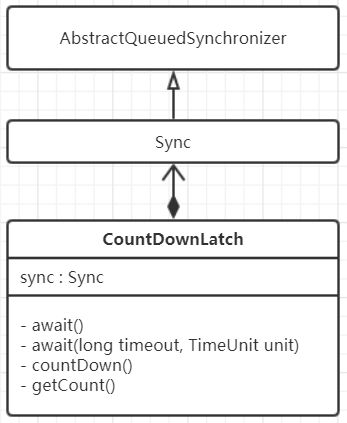要点解说
CountDownLatch允许一个或者多个线程一直等待,直到一组其它操作执行完成。在使用CountDownLatch时,需要指定一个整数值,此值是线程将要等待的操作数。当某个线程为了要执行这些操作而等待时,需要调用await方法。await方法让线程进入休眠状态直到所有等待的操作完成为止。当等待的某个操作执行完成,它使用countDown方法来减少CountDownLatch类的内部计数器。当内部计数器递减为0时,CountDownLatch会唤醒所有调用await方法而休眠的线程们。
实例演示
下面代码演示了CountDownLatch简单使用。演示的场景是5位运动员参加跑步比赛,发令枪打响后,5个计时器开始分别计时,直到所有运动员都到达终点。
public class CountDownLatchDemo {
public static void main(String[] args) {
Timer timer = new Timer(5);
new Thread(timer).start();
for (int athleteNo = 0; athleteNo < 5; athleteNo++) {
new Thread(new Athlete(timer, "athlete" + athleteNo)).start();
}
}
}
class Timer implements Runnable {
CountDownLatch timerController;
public Timer(int numOfAthlete) {
this.timerController = new CountDownLatch(numOfAthlete);
}
public void recordResult(String athleteName) {
System.out.println(athleteName + " has arrived");
timerController.countDown();
System.out.println("There are " + timerController.getCount() + " athletes did not reach the end");
}
@Override
public void run() {
try {
System.out.println("Start...");
timerController.await();
System.out.println("All the athletes have arrived");
} catch (InterruptedException e) {
e.printStackTrace();
}
}
}
class Athlete implements Runnable {
Timer timer;
String athleteName;
public Athlete(Timer timer, String athleteName) {
this.timer = timer;
this.athleteName = athleteName;
}
@Override
public void run() {
try {
System.out.println(athleteName + " start running");
long duration = (long) (Math.random() * 10);
Thread.sleep(duration * 1000);
timer.recordResult(athleteName);
} catch (InterruptedException e) {
e.printStackTrace();
}
}
}
输出结果如下所示:
Start...
athlete0 start running
athlete1 start running
athlete2 start running
athlete3 start running
athlete4 start running
athlete0 has arrived
There are 4 athletes did not reach the end
athlete3 has arrived
There are 3 athletes did not reach the end
athlete2 has arrived
athlete1 has arrived
There are 1 athletes did not reach the end
There are 2 athletes did not reach the end
athlete4 has arrived
There are 0 athletes did not reach the end
All the athletes have arrived
方法解析
1.构造方法
CountDownLatch(int count)构造一个指定计数的CountDownLatch,count为线程将要等待的操作数。
2.await()
调用await方法后,使当前线程在锁存器(内部计数器)倒计数至零之前一直等待,进入休眠状态,除非线程被中断。如果当前计数递减为零,则此方法立即返回,继续执行。
3.await(long timeout, TimeUnit unit)
调用await方法后,使当前线程在锁存器(内部计数器)倒计数至零之前一直等待,进入休眠状态,除非线程被 中断或超出了指定的等待时间。如果当前计数为零,则此方法立刻返回true值。
4.acountDown()
acountDown方法递减锁存器的计数,如果计数到达零,则释放所有等待的线程。如果当前计数大于零,则将计数减少。如果新的计数为零,出于线程调度目的,将重新启用所有的等待线程。
5.getCount()
调用此方法后,返回当前计数,即还未完成的操作数,此方法通常用于调试和测试。
源码解析
进入源码分析之前先看一下CountDownLatch的类图,
Sync是CountDownLatch的一个内部类,它继承了AbstractQueuedSynchronizer。
CountDownLatch(int count)、await()和countDown()三个方法是CountDownLatch的核心方法,本篇将深入分析这三个方法的具体实现原理。
1.CountDownLatch(int count)
public CountDownLatch(int count) {
if (count < 0) throw new IllegalArgumentException("count < 0");
this.sync = new Sync(count);
}
该构造方法根据给定count参数构造一个CountDownLatch,内部创建了一个Sync实例。Sync是CountDownLatch的一个内部类,其构造方法代码如下:
Sync(int count) {
setState(count);
}
setState方法继承自AQS,给Sync实例的state属性赋值。
protected final void setState(int newState) {
state = newState;
}
这个state就是CountDownLatch的内部计数器。
2.await()
当await()方法被调用时,当前线程会阻塞,直到内部计数器的值等于零或当前线程被中断,下面深入代码分析。
public void await() throws InterruptedException {
sync.acquireSharedInterruptibly(1);
}
public final void acquireSharedInterruptibly(int arg)
throws InterruptedException {
//如果当前线程中断,则抛出InterruptedException
if (Thread.interrupted())
throw new InterruptedException();
//尝试获取共享锁,如果可以获取到锁直接返回;
//如果获取不到锁,执行doAcquireSharedInterruptibly
if (tryAcquireShared(arg) < 0)
doAcquireSharedInterruptibly(arg);
}
//如果当前内部计数器等于零返回1,否则返回-1;
//内部计数器等于零表示可以获取共享锁,否则不可以;
protected int tryAcquireShared(int acquires) {
return (getState() == 0) ? 1 : -1;
}
//返回内部计数器当前值
protected final int getState() {
return state;
}
//该方法使当前线程一直等待,直到当前线程获取到共享锁或被中断才返回
private void doAcquireSharedInterruptibly(int arg)
throws InterruptedException {
//根据当前线程创建一个共享模式的Node节点
//并把这个节点添加到等待队列的尾部
//AQS等待队列不熟悉的可以查看AQS深入解析的内容
final Node node = addWaiter(Node.SHARED);
boolean failed = true;
try {
for (;;) {
//获取新建节点的前驱节点
final Node p = node.predecessor();
//如果前驱节点是头结点
if (p == head) {
//尝试获取共享锁
int r = tryAcquireShared(arg);
//获取到共享锁
if (r >= 0) {
//将前驱节点从等待队列中释放
//同时使用LockSupport.unpark方法唤醒前驱节点的后继节点中的线程
setHeadAndPropagate(node, r);
p.next = null; // help GC
failed = false;
return;
}
}
//当前节点的前驱节点不是头结点,或不可以获取到锁
//shouldParkAfterFailedAcquire方法检查当前节点在获取锁失败后是否要被阻塞
//如果shouldParkAfterFailedAcquire方法执行结果是当前节点线程需要被阻塞,则执行parkAndCheckInterrupt方法阻塞当前线程
if (shouldParkAfterFailedAcquire(p, node) &&
parkAndCheckInterrupt())
throw new InterruptedException();
}
} finally {
if (failed)
cancelAcquire(node);
}
}
private Node addWaiter(Node mode) {
//根据当前线程创建一个共享模式的Node节点
Node node = new Node(Thread.currentThread(), mode);
// Try the fast path of enq; backup to full enq on failure
Node pred = tail;
//如果尾节点不为空(等待队列不为空),则新节点的前驱节点指向这个尾节点
//同时尾节点指向新节点
if (pred != null) {
node.prev = pred;
if (compareAndSetTail(pred, node)) {
pred.next = node;
return node;
}
}
//如果尾节点为空(等待队列是空的)
//执行enq方法将节点插入到等待队列尾部
enq(node);
return node;
}
//这里如果不熟悉的可以查看AQS深入解析的内容
Node(Thread thread, Node mode) { // Used by addWaiter
this.nextWaiter = mode;
this.thread = thread;
}
private Node enq(final Node node) {
//使用循环插入尾节点,确保成功插入
for (;;) {
Node t = tail;
//尾节点为空(等待队列是空的)
//新建节点并设置为头结点
if (t == null) { // Must initialize
if (compareAndSetHead(new Node()))
tail = head;
} else {
//否则,将节点插入到等待队列尾部
node.prev = t;
if (compareAndSetTail(t, node)) {
t.next = node;
return t;
}
}
}
}
//获取当前节点的前驱节点
final Node predecessor() throws NullPointerException {
Node p = prev;
if (p == null)
throw new NullPointerException();
else
return p;
}
//判断当前节点里的线程是否需要被阻塞
private static boolean shouldParkAfterFailedAcquire(Node pred, Node node) {
//前驱节点线程的状态
int ws = pred.waitStatus;
//如果前驱节点线程的状态是SIGNAL,返回true,需要阻塞线程
if (ws == Node.SIGNAL)
return true;
//如果前驱节点线程的状态是CANCELLED,则设置当前节点的前去节点为"原前驱节点的前驱节点"
//因为当前节点的前驱节点线程已经被取消了
if (ws > 0) {
do {
node.prev = pred = pred.prev;
} while (pred.waitStatus > 0);
pred.next = node;
} else {
//其它状态的都设置前驱节点为SIGNAL状态
compareAndSetWaitStatus(pred, ws, Node.SIGNAL);
}
return false;
}
//通过使用LockSupport.park阻塞当前线程
//同时返回当前线程是否中断
private final boolean parkAndCheckInterrupt() {
LockSupport.park(this);
return Thread.interrupted();
}
3.countDown()
内部计数器减一,如果计数达到零,唤醒所有等待的线程。
public void countDown() {
sync.releaseShared(1);
}
public final boolean releaseShared(int arg) {
//如果内部计数器状态值递减后等于零
if (tryReleaseShared(arg)) {
//唤醒等待队列节点中的线程
doReleaseShared();
return true;
}
return false;
}
//尝试释放共享锁,即将内部计数器值减一
protected boolean tryReleaseShared(int releases) {
for (;;) {
//获取内部计数器状态值
int c = getState();
if (c == 0)
return false;
//计数器减一
int nextc = c-1;
//使用CAS修改state值
if (compareAndSetState(c, nextc))
return nextc == 0;
}
}
private void doReleaseShared() {
for (;;) {
//从头结点开始
Node h = head;
//头结点不为空,并且不是尾节点
if (h != null && h != tail) {
int ws = h.waitStatus;
if (ws == Node.SIGNAL) {
if (!compareAndSetWaitStatus(h, Node.SIGNAL, 0))
continue;
//唤醒阻塞的线程
unparkSuccessor(h);
}
else if (ws == 0 &&
!compareAndSetWaitStatus(h, 0, Node.PROPAGATE))
continue;
}
if (h == head)
break;
}
}
private void unparkSuccessor(Node node) {
int ws = node.waitStatus;
if (ws < 0)
compareAndSetWaitStatus(node, ws, 0);
Node s = node.next;
if (s == null || s.waitStatus > 0) {
s = null;
for (Node t = tail; t != null && t != node; t = t.prev)
if (t.waitStatus <= 0)
s = t;
}
if (s != null)
//通过使用LockSupport.unpark唤醒线程
LockSupport.unpark(s.thread);
}
原理总结
使用CountDownLatch(int count)构建CountDownLatch实例,将count参数赋值给内部计数器state,调用await()方法阻塞当前线程,并将当前线程封装加入到等待队列中,直到state等于零或当前线程被中断;调用countDown()方法使state值减一,如果state等于零则唤醒等待队列中的线程。
实战经验
实际工作中,CountDownLatch适用于如下使用场景:
客户端的一个同步请求查询用户的风险等级,服务端收到请求后会请求多个子系统获取数据,然后使用风险评估规则模型进行风险评估。如果使用单线程去完成这些操作,这个同步请求超时的可能性会很大,因为服务端请求多个子系统是依次排队的,请求子系统获取数据的时间是线性累加的。此时可以使用CountDownLatch,让多个线程并发请求多个子系统,当获取到多个子系统数据之后,再进行风险评估,这样请求子系统获取数据的时间就等于最耗时的那个请求的时间,可以大大减少处理时间。
面试考点
CountDownLatch和CyclicBarrier的异同?
相同点:都可以实现线程间的等待。
不同点:
1.侧重点不同,CountDownLatch一般用于一个线程等待一组其它线程;而CyclicBarrier一般是一组线程间的相互等待至某同步点;
2.CyclicBarrier的计数器是可以重用的,而CountDownLatch不可以。
最后
针对于上面的文章我总结出了互联网公司java程序员面试涉及到的绝大部分面试题及答案做成了文档和架构视频资料免费分享给大家(包括Dubbo、Redis、Netty、zookeeper、Spring cloud、分布式、高并发等架构技术资料),希望能帮助到您面试前的复习且找到一个好的工作,也节省大家。
资料免费领取方式:加qun群:956011797点击立即加入 找管理小姐姐免费获取!
更多架构专题及视频资料展示如下:
资料免费领取方式:加qun群:956011797点击立即加入 找管理小姐姐免费获取!
